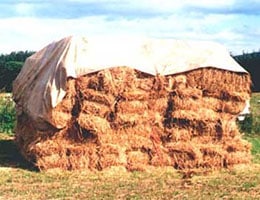 The term hay comes from the Latin word fenum . The concept refers to a plant that is part of the grass group, characterized by its thin canes and narrow leaves.
The term hay comes from the Latin word fenum . The concept refers to a plant that is part of the grass group, characterized by its thin canes and narrow leaves.
Being included in the group of grasses, hay is also a monocotyledonous angiosperm plant. This means that its carpels form an ovary that contains the ovules and that its embryo has a single cotyledon (first leaf). Furthermore, as an angiosperm, it is a phanerogamous species because its reproductive organs are visible as flowers.
In a broader sense, dry grass used to feed livestock is called hay. It can be a mixture of different species, such as wheat, barley, oats and ryegrass.
Depending on the material of the leaves, the hay can be of higher or lower quality . In certain areas, due to climatic characteristics, it is common for the nutritional value of hay to be reduced.
Hay is generally harvested with machinery and then processed for storage in piles or bales . It can be used to feed cows, sheep, horses and goats, and in certain cases also pigs (although this animal has difficulties digesting it).
Hay is usually used when fresh grass is scarce or has characteristics that prevent digestion . In such cases it is common to resort to making hay to feed the livestock.
It should be noted that, in some regions , hay is stored in haystacks : open-air mounds that develop around a vertically arranged pole.
The process of mowing and baling hay is a very important part of the daily lives of farmers and farmers who must feed their animals. As mentioned above, nowadays the use of machinery is very common and that is why it is necessary to check it approximately a month before starting haymaking to avoid delays due to breakdowns, for example.
 If we find clovers or alfalfa in the hayfield, among other legumes, it may become necessary to advance the harvest , generally at the time when they are no more than 20 percent complete. The leaves should be cut when they have fully developed because if we rush we will obtain a smaller harvest and if we wait too long, their nutritional content will decrease.
If we find clovers or alfalfa in the hayfield, among other legumes, it may become necessary to advance the harvest , generally at the time when they are no more than 20 percent complete. The leaves should be cut when they have fully developed because if we rush we will obtain a smaller harvest and if we wait too long, their nutritional content will decrease.
It is very important to wait until at least three days of dry weather has passed before cutting the hay, so it can be properly cured and baled. Generally, we have two weeks to cut the hay without risking it losing its properties .
To cut hay, it is recommended to use a mower with a sickle -shaped bar, a rotary disc mower or a conditioner. The extent of the terrain is usually the determining factor of the most appropriate equipment for the task, which is why observation and knowledge of the soil is necessary. When we complete this step, we should rotate the hay at least once during the next three days, although we should not exaggerate the number of turns to avoid breaking off too many pieces of grass and seeds.
The goal of turning hay is to dry it before storing it . It is precisely this aspect that we must take into account during the three days that it is usually left in the sun to make the decision to rotate it. To measure its internal moisture content, it is necessary to examine it frequently. Before packaging it, it should reach a state in which it feels crispy but does not crumble very easily.
